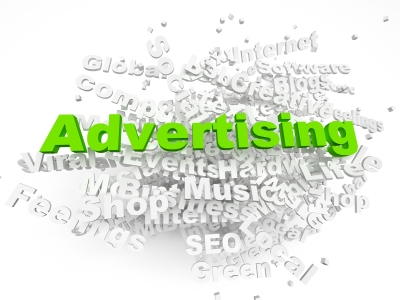Entries Tagged 'advertising copywriting' ↓
February 10th, 2014 — Advertising, advertising copywriting, marketing, Sales Letters

Let me give you a clue.
“The number of ideas to use in an ad should be odd – and three’s too many”
Timo Everi, Hasan & Partners Helsinki
I couldn’t put it better myself.
The key to any form of marketing is clarity (of course it also has to be persuasive, but for the purpose of this post, clarity wins through).
If you want your reader to be 100% clear about what you’re telling them you can’t bombard them with umpteen messages at once.
A classic example of this is a sales letter.
Years ago, a client wanted a sales letter. We agreed terms and I got to work. After a while he had a brain wave; by getting me to include 2 products within one letter, he would only have to pay me once to sell twice as much.
Wrong.
Trying to squeeze two ideas into one letter merely dilutes its effectiveness. To have any sort of effect you must concentrate on one idea and exploit it to the max.
Maintaining the focus of the reader is essential. If you present them with one idea, they can follow your reasoning and benefits. But if you start telling them one thing and then add “…we also offer…” they’re suddenly all at sea.
Powerful copy focuses on just one idea:
- It shows the reader how they will benefit from that one idea
- They’ll understand how their life will be enriched by that one idea
- They’ll be left with no other choice than to buy into your idea
What at first might seem a financially driven ‘smart’ move will only end up with disappointing results.
Regardless of what piece of marketing you’re creating:
- Stick to one idea
- Focus your message on your reader
- Show how they will benefit
- Tell them how to buy
Author: Sally Ormond
October 30th, 2013 — Advertising, advertising copywriting
It’s everywhere. 
From the moment you open your eyes in the morning you are subjected to a barrage of advertising. Whether it’s on the radio, in newspapers, on billboards, on the Tube, bus or train…everywhere you go, it’s staring you in the face.
But are you taking any notice of it?
Have a think about yesterday – how many adverts do you remember seeing?
I’m willing to bet not that many.
That’s quite worrying if you’re in the advertising industry.
In Dave Trott’s book ‘Predatory Thinking – A Masterclass in Out-thinking the Competition’ (well worth a read by the way), he stated that out of an annual £18.3 billion spend (that’s on all forms of advertising):
- 89% of advertising isn’t noticed or remembered
- 4% is remembered positively
- 7% is remembered negatively
So that means UK businesses are wasting £17.3 billion. That’s got to hurt.
But advertising isn’t about producing something clever. Granted it needs to get you noticed (even if it as one of the 7%), but more than that, it needs to make people want to buy.
There’s a lot of talk these days about using advertising to raise brand awareness. That’s just a way for advertising agencies to produce ads that aren’t measureable.
According to Wikipedia, advertising is:
“…a form of communication for marketing…used to encourage, persuade, or manipulate an audience…to continue or take some new action.”
To my mind that means buying.
Your advertisement, in whatever form it takes, has to sell, otherwise what’s the point?
So when planning your next advertisement project think about your customers and what will make them buy – I’m pretty sure it’s not a flash ad that doesn’t tell them anything (O2’s ‘Be more dog’ springs to mind).
- What do they want?
- Why do they need it?
- What will it mean to them when they have it?
Answer those questions and you’ll be on your way to a raft of new customers.
What do you reckon?
What’s your take on this?
Is advertising too much about agencies touting for awards? Has the whole concept of advertising (i.e. to sell) been lost?
When was the last time you were sold to by an advert? What made it stand out for you?
Leave a comment below as this is a subject that needs a good debate.
Image courtesy of David Castillo Dominici/FreeDigitalPhotos
October 23rd, 2013 — Advertising, advertising copywriting, marketing

Have you ever had an original thought?
Something no one else has ever thought of?
Probably not, after all, with the many millions of people in the world (past and present) it’s a tall order to come up with something completely original.
So where does that leave your marketing strategy?
Is it a bit predictable?
Well, now’s the time to do something about it.
Recently, I was lucky enough to hear Dave Trott speak at the Professional Copywriter Network conference in London.
He talked out how important it is to out-think your competitors.
For example, if your business has 8 direct competitors (your products are the same) and your campaigns are very similar, there’s nothing for your consumers to distinguish between you.
The chances are your market share has stagnated or is reducing – neither of which are good.
So what do you do?
You have to out-think your competitors.
During Dave’s hugely entertaining presentation (if you get the chance to hear him speak, grab it with both hands) he illustrated the point with an example of one of his own advertising projects.
A few years ago Dave was tasked with coming up with an advertising campaign to prevent chip pan fires.
Previously, the issue had been tackled by showing how quickly a fire could take hold, each incarnation more gruesome than the one before. But these tactics weren’t working.
It was time for someone to look at things differently.
Rather than taking the traditional view of ‘to prevent fires we must show the audience what will happen if they have a chip pan fire’, Dave opted to look at it from a different angle.
If there were lots of chip pan fires that meant the fire brigade would be called out to lots of fires. So instead of showing housewives the devastating effect of fire, Dave chose to find a way to reduce those call outs.
So Dave produced an advert that showed housewives how to deal with a chip pan fire safely, therefore reducing the number of call outs.
That’s (award winning) creative thinking.
It’s not looking at the obvious need, but instead turning the problem on its head and looking for another, possibly easier, problem to solve.
So next time you create a marketing campaign, apply a different way of thinking. Look at every aspect of what you’re trying to achieve to see if you can come up with something that’s going to make you stand out.
For more about out-thinking your competition, Dave has a ‘must read’ book out called “Predatory Thinking – A Masterclass in Out-Thinking The Competition” (link to Amazon page).
July 30th, 2012 — Advertising, advertising copywriting, copywriter, copywriting tips, marketing, social media, social media marketing
If you think marketing and advertising are one and the same, there’s a pretty good chance your marketing efforts are being less than successful. 
If you cast your mind back to the bad old days, companies would advertise to you left right and centre. You would be bombarded by less than subtle sales messages wherever you went.
Our TVs, magazines, newspapers and mailboxes were full of ‘buy from us now’ messages desperate to grab your hard earned cash.
But the landscape looks very different these days, with businesses moving away from advertising and towards marketing.
Nope, still don’t get it
In that case, you’re probably a business that has dabbled in social media, blogging, article and video marketing only to decide that it doesn’t work for you.
Well, the reason it’s not working is probably because you’re still advertising rather than marketing.
Let me explain.
If you’re advertising, you’re effectively shouting at your customers ‘buy now’ with little regard for what they actually want.
Perhaps that approach used to work for you, but today’s consumers want more than that, they want to be appreciated, wooed and persuaded.
The subtle art of marketing
Today’s marketing channels are social media, video and article marketing and blogging. Each of these disciplines offers the consumer engagement, information, and advice – effectively something for nothing. Or at least that is how it appears.
You see, people now want to feel as though you, as a company, value them and their business. They don’t just want you to come along, take their money and then head off into the night.
Today, you must engage with them, talk to them, offer them great information, be responsive to their questions and generally take in interested in what they want. And that’s why you must market and not advertise to them.
You see, marketing is all about getting to know your customer and being interested in what they really want, their likes and dislikes and being prepared to chat with them to build relationships.
Think carefully about them and how your product or service will benefit them and then show them.
The days of the blatant advertising are numbered; today your consumers want more. Talk to them, engagement with them and give them something for nothing. As you do so something magical happens, they begin to trust you and that trust will be manifested in the form of their credit card.
Market to your customers and they’ll be customers for life.
January 2nd, 2012 — advertising copywriting, email marketing, internet marketing, marketing, online marketing
 It’s been like a slow train coming – more and more marketing is being turned over to digital formats, whether that’s websites, emails, e-newsletters, QR codes, video or social media.
It’s been like a slow train coming – more and more marketing is being turned over to digital formats, whether that’s websites, emails, e-newsletters, QR codes, video or social media.
Although brochures and leaflets etc., still hold a valid place in your marketing armoury, you do begin to wonder how long that will remain so. After all, if we look at consumer behaviour, it would suggest they will soon become a dim and distant memory like the humble pound note or vinyl.
The consumer leads the way
That’s where it all started (well, in my world anyway) – with music. I started off buying tapes of my favourite bands or vinyl singles. They were the best as far as I was concerned; that was until the CD arrived.
It wasn’t long before I was seduced by those shiny discs and my vinyl and tapes were consigned to the history books (and our loft). I thought CDs were the pinnacle – nothing could surpass their sound quality. But a few years down the line and I was confronted by the iPod and digital music downloads.
So, you guessed it, eventually I converted to downloading my music.
The same is happening to books.
A staunch lover of an actual book, I have vowed never to go over to the digital side. I love the feel and smell of a book; the ability to thumb through pages. I don’t care how cluttered my house gets (I simply can’t part with my books), I love browsing through book shops and buying books.
But, the other day I really wanted to read. Not having a book to hand (one that I hadn’t previously read), unable to wait for Amazon to deliver one, and certainly unwilling to brave the pre-Christmas crush in town, I did the unthinkable.
I reached for my iPad and, yes that’s right, downloaded a book.
Expecting to hate the experience, I have to say it’s not a bad way to read. Granted, I don’t have the physical book to touch or smell, but I can use a digital book mark, turn the pages almost as I would in real life, and enjoy it
That illustrates how consumers are embracing new technology and paving the way for change simply by accepting it.
We’ve already seen more and more people engage in online shopping rather than hitting the High Street, online banking, video calling, and social media – so perhaps the era of print marketing is drawing to a close.
The online way
Perhaps now companies should be investing more into their online presence. With the search boom continuing, their budgets may well be more wisely spent on search engine optimisation, professional copywriters, mobile websites, video and social media.
It would certainly appear that the effectiveness of print adverts is dwindling. So is this the beginning of the end?
What do you think?
Do you think we’re coming to the end of the print advertising era?
Leave a comment below, I’d love to hear your views.










